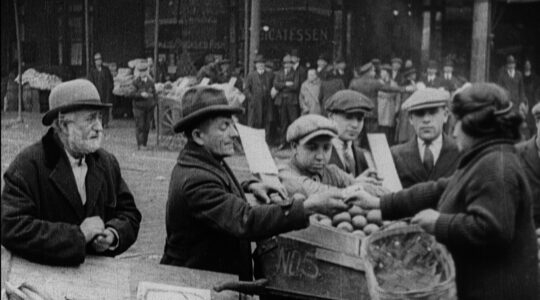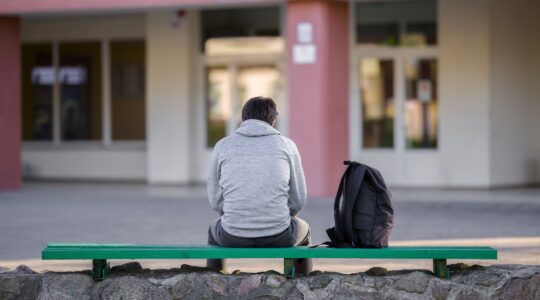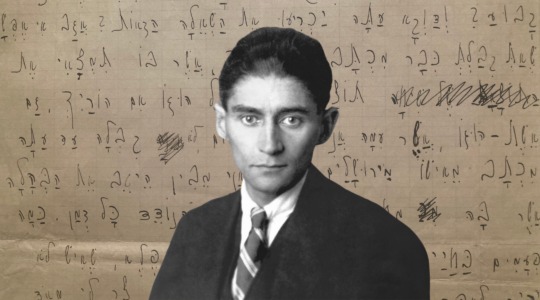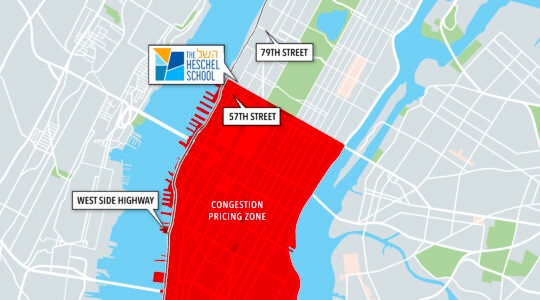Newspapers famously cover accidents, or celebrity couples, rather than airplanes landing safely, or the news that somewhere a lonely heart was kissed. But this was a year when newspapers from The Wall Street Journal to tabloids covered the sun coming up — on April 8, an ordinary sunrise, no less or more glorious than any other — simply because we endowed that dawn with our “Blessing of the Sun.” So let us keep sanctifying simple gifts.
Rosh HaShanah’s other name is Yom HaZikaron, a Day of Remembering. With an autumn chill blowing through too many lives and headlines, we can nevertheless say of our gifts, as did Yeats, that this is a world so beautiful that it’s a wonder that anyone does anything around
here except dream and remember.
Lower the flag and play Taps in the year’s twilight, but remember while reading the “year in review” that there was more to it all than headlines of prime ministers, presidents and Ponzi schemers. “Y’know, Babylon once had two million people in it,” says the Stage Manager in “Our Town,” “and all we know about ’em is the names of the kings and some copies of wheat contracts … Yet every night all those families sat down to supper, and the father came home from work, and the smoke went up the chimney, same as here … Some things are eternal,” and those eternal truths are the essence of who we are, and where we’ve been.
The themes of the Days of Awe are ever-present in hard times. There was a recent Internet sensation, a “last lecture” by a dying professor. Articles ask, “What would you do if you had one year to live?” An article in Haaretz was headlined, “If Israel Only Had One Year To Live.” If you knew that you had 20 years left, or 60, is that any less startling?
As Beckett said, the last day of your life will be like any other, only shorter.
These are the days when the fate of communities are inscribed, to live or die, just like people.
Who remembers the last day that the Grand Concourse was a great Jewish community? That last day must have seemed like any other.
In 1906, men wearing silk hats and riding in carriages came to the dedication of the new Tremont Temple, on what would become the Concourse. One congregant, decades ago, told a newspaper, “the Concourse was really grand back then. We rode horses on a path along one side. There were only private homes, no apartments.”
That temple had its “building fund.” Who knew that the expensive building would be just slightly more temporary than a tent?
Speaking to us by phone, Constance Rosenblum, author of the new book, “Boulevard of Dreams” (NYU Press), on the occasion of the Concourse’s centennial, described that Reform temple, now a church, as “a beautiful Georgian building with red brick and white columns and a triangular roof. It’s still very lovely.”
Up and down the Concourse, men built shuls to last forever. Adath Israel, opening in 1928, “was the premier temple in the Bronx, I think it’s fair to say, certainly for Conservatives,” says Rosenblum. “Physically, it isn’t all that different today. Adath Israel is still a gorgeous limestone building, still with its beautiful stained glass Old Testament images. The ceiling, if I remember, was blue with little stars. The Seventh Day Adventists are very proud to be there.”
The Concourse on holy days was “very conspicuously Jewish,” says Rosenblum. “Jews would promenade down the boulevard in their beautiful outfits,” women in mink stoles, men in Homburgs, many on the way to Joyce Kilmer Park, on 161st Street, across from the Bronx Courthouse. They called it Yom Kippur Park, for its congregants.
Then one Yom Kippur the neighborhood was inscribed for dispersion. Somewhere in the 1960s the Jewish Concourse became “like withering grass, a passing shadow, scattering dust, a vanishing dream,” in the words of the holiday prayer. The Jews who didn’t move away wouldn’t come out after dark. The days were like any other, only shorter. There were police sirens in the night, buildings were burning on side streets, and even behind locked doors, Jews asleep in their beds were awakened by intruders.
Like a sinking Atlantis, the shuls sent out distress calls to other neighborhoods, looking for someone to take their Torahs, even their name, to remember. In 1973, Adath Israel wrapped each Torah in a tallit and drove six miles to higher ground, to a place now named the Conservative Synagogue Adath Israel of Riverdale.
In 1976, Tremont Temple put its Torahs on a bus to what is now known as Scarsdale Synagogue, Temples Tremont and Emanu-El.
The end “didn’t happen overnight,” says Rosenblum. “Nothing does. But it seemed that one minute you had this idyllic world — which, of course, was not that idyllic for everybody — and in the next minute a way of life was just erased.”
When it was over, what turned out to be eternal was not the architecture, the holiday promenades, the celebrated clergy or even the Eternal Lights now shining on others. What was eternal, as Thornton Wilder wrote, was only what the saints and the poets knew all along.
The Concourse Torahs, of course, were more easily sent to Scarsdale than were the middle-class people. For them, Co-Op City “emptied out the Concourse,” says Rabbi Solomon Berl, the senior rabbi in the Bronx, serving since 1948.
They blessed the sun in Co-Op City, this past year, and the sun comes up daily over the towering apartments just as it did over Freedomland, the amusement park that was destroyed to make room for the apartments in the mid-1960s; just as the sun came up over the private homes, farms and the marshland preceding that.
In the 1960s, a rabbi in the Bronx could go east or west. Rabbi Berl’s cousin, Blu Greenberg and her husband, Rabbi Yitz Greenberg, went west, to Riverdale Jewish Center, then a sparse community as new and uncertain as a colt on spindly legs.
Rabbi Berl went east, to 60,000 people in Co-Op City, 85 percent Jewish. He founded the Young Israel of Co-Op City in 1968.
“Every Shabbos I’d see 30 or 40 new families,” says Rabbi Berl. “One time, I looked around my shul and counted nine or 10 presidents from old Concourse shuls, along with a few retired rabbis. At times it wasn’t so easy,” he laughs. “Everyone was used to being a big shot.”
Now, say Rabbi Berl, Co-Op City is 3 percent Jewish, but he doesn’t really see it that way. Three percent? Every soul is 100 percent. In this 21st century when so many rabbis are consultants, think-tankers, scholars-in-residence, assisted by a flock of assistant rabbis and interns, Rabbi Berl, 84, is a throwback, akin to Burt Lancaster’s elderly Moonlight Graham in “Field of Dreams,” a country doctor of a rabbi, without secretary or staff. He’s the cantor, speech maker, baal koreh (Torah reader), shofar blower, the local kashrut supervisor; he answers all the phones, and he sells the High Holiday tickets. On the side, he teaches at Yeshiva University’s Belz School of Jewish Music, and he explains to the landlord why his shul can’t pay the rent.
“It’s getting harder for me to do everything,” says Rabbi Berl, “but the work doesn’t bother me at all. I just hope my voice holds up for the davening.”
He even writes — in longhand — a column for local community papers, about “love, brotherhood, friendship, ethics. … I get more compliments from the blacks than my own people,” he says, bemused. “My readers are mostly non-Jews. I do it mainly for one reason: To remind people that there’s a Jewish presence here.”
Lois Berl Usdan, the rabbi’s daughter and a teacher at the Hebrew Academy of the Five Towns, recalls going with her parents to the Hutchinson River for Tashlich — the traditional casting of “sins” into flowing water — on their first Rosh HaShanah in Co-Op City. “Now mind you,” she says, “at that point there were maybe one or two paved streets, there were piles of rubble and heaps of dirt alongside tractors and bulldozers. We were walking and my mother says, ‘Turn around. Look behind us.’ There were hundreds and hundreds of people! When we arrived at the river, all shrubbery and weeds, everyone was so excited!
“Now, of course,” she explains, “it’s only a handful of people walking with my father, but as he walks, black people, Asians, all the non-Jews wave and say, ‘Happy New Year! Hi, Rabbi, going to the water?’ It’s still an event.”
He expects 125 congregants for the holidays, but tickets remain unsold.
His wife Eleanor is in the Other World. Every month for his shul is an unpaid rent. He could be forgiven if all he did was dream and remember.
“But really,” he says, “it was a beautiful experience; it’s beautiful still.”
And that’s the entire davening in one sentence.
The New York Jewish Week brings you the stories behind the headlines, keeping you connected to Jewish life in New York. Help sustain the reporting you trust by donating today.




